Key takeaways
- Concert photo editing captures the energy and emotion of performances, balancing authenticity with enhancements to make images resonate.
- Using the right tools, like Adobe Lightroom and graphic tablets, allows for more precise adjustments and creative control over photos.
- Preparing and organizing photos by lighting and energy boosts the editing process, helping to maintain the vibe of the concert.
- Effective sharing involves timing, adding context to images, and selecting the right platforms to engage fans and evoke shared memories.
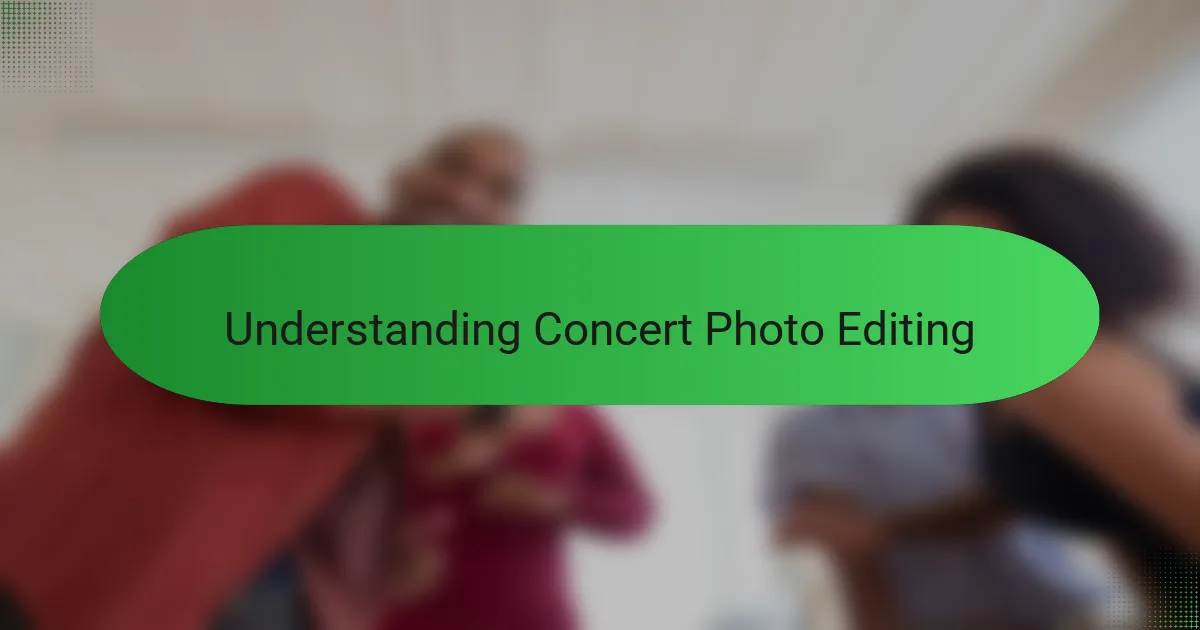
Understanding Concert Photo Editing
Concert photo editing is more than just tweaking brightness or contrast; it’s about capturing the raw energy and emotion of the moment. When I first started editing photos from the Bon Jovi show, I realized that every shot had its own story waiting to be told through color correction and cropping. Have you ever glanced at a photo and felt it lacked the spark you remembered? That’s where thoughtful editing makes all the difference.
I often find myself balancing between preserving the authentic concert atmosphere and enhancing details that were lost in dim lighting or fast movement. It’s a delicate dance—overdo it, and the image feels artificial; underdo it, and it looks flat and lifeless. For me, the goal is to make you feel like you’re right there, front row, soaking in the guitar riffs and the crowd’s roar.
Understanding the challenges of concert photography—like messy stage lights and unpredictable angles—helps me approach editing with patience and purpose. I ask myself, how can I reveal the passion Brian and the band pour into every performance through each image? That thoughtful mindset is what turns an ordinary concert snap into a snapshot of rock history.
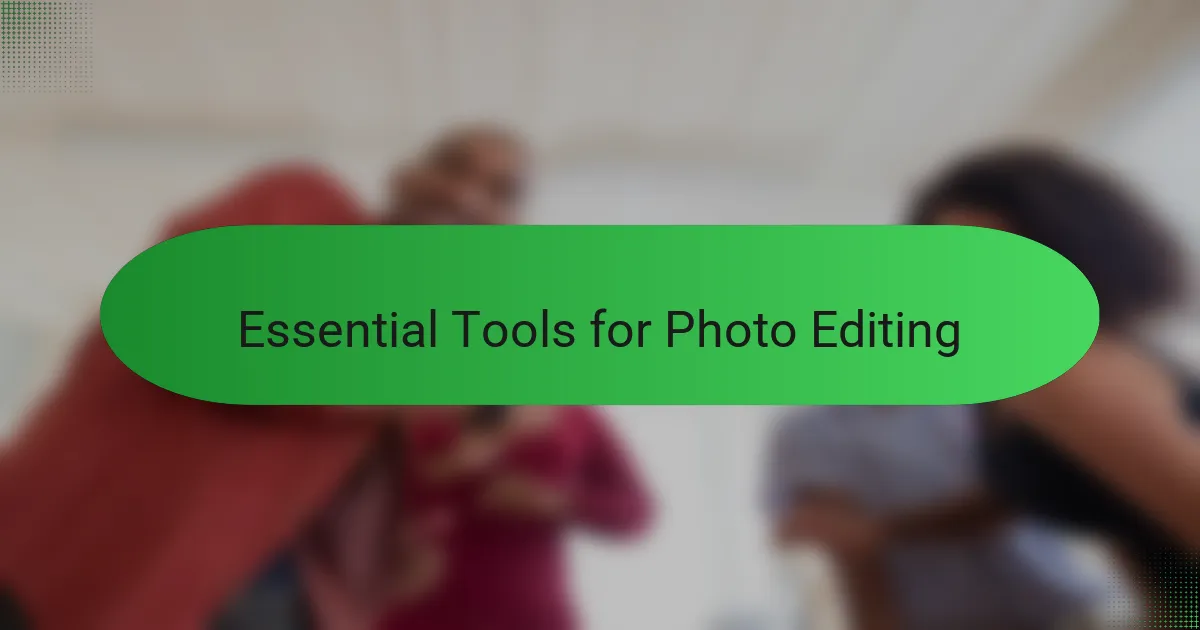
Essential Tools for Photo Editing
When I dive into editing concert photos, having the right tools feels like having the perfect guitar for a solo—essential and irreplaceable. I always rely on software like Adobe Lightroom for its intuitive interface and powerful color grading options that help me bring out the intensity of the stage lights without washing out the raw energy. Have you ever tried adjusting a photo’s white balance and suddenly noticed the sweat glistening on Jon Bon Jovi’s forehead? It’s these little details that make editing so rewarding.
Beyond software, a good mouse or graphic tablet is surprisingly vital. When I first switched from a trackpad to a tablet, my ability to make precise selections and subtle brush adjustments skyrocketed. It’s like having finer control over every note in a riff—without it, details get lost, and the photo can look flat. Sometimes, the difference between a decent edit and a striking one comes down to how easily I can manipulate tiny areas in the image.
I also keep a set of presets and custom filters handy, which is a bit like having a signature sound. These tools speed up my workflow by letting me quickly apply a consistent mood across all photos from the same show. But I never rely on them blindly—each shot needs a personal touch. Don’t you agree that even the coolest preset can’t capture the unique vibe of a moment—the smoky haze, the crowd’s energy, that split second when the spotlight hits the lead singer’s face just right?
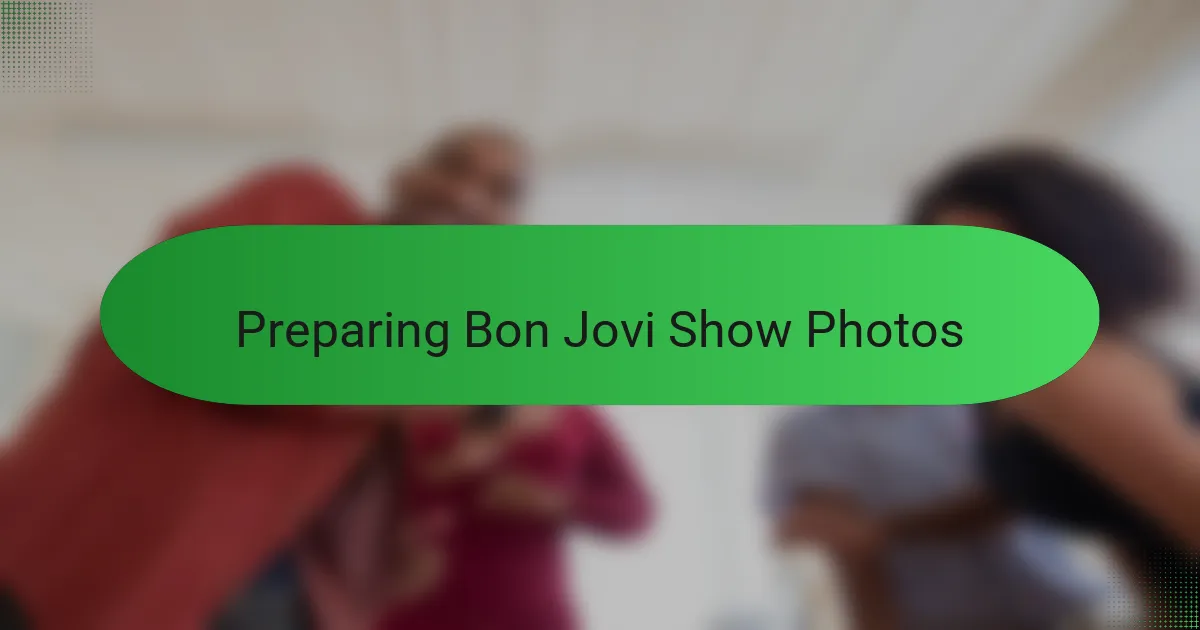
Preparing Bon Jovi Show Photos
Preparing the Bon Jovi show photos always begins with sifting through hundreds of shots to find those gems that truly capture the spirit of the night. I remember scrolling through my first batch and feeling overwhelmed—not every photo screams “rock ‘n’ roll magic,” but those that do become my focus. Have you ever noticed how the right expression or a perfectly timed guitar solo freeze-frame can transform a photo from ordinary to unforgettable?
Once I select the best images, I like to organize them by lighting conditions and energy levels. This helps me tailor my editing approach because a close-up under harsh spotlights needs a different touch than a wide crowd shot soaked in colored haze. From experience, this preparation step not only streamlines my workflow but also builds anticipation—as if I’m reheating the night’s vibe before the real work begins.
I also make it a point to mentally relive the concert while prepping the photos. Sometimes, just recalling the booming bass or Jon’s voice soaring over the crowd helps me decide how vibrant or moody the edit should be. Does this sound a bit abstract? Maybe—but for me, preparing these photos means reconnecting with the emotion I felt in that moment and striving to pass it on through every pixel.
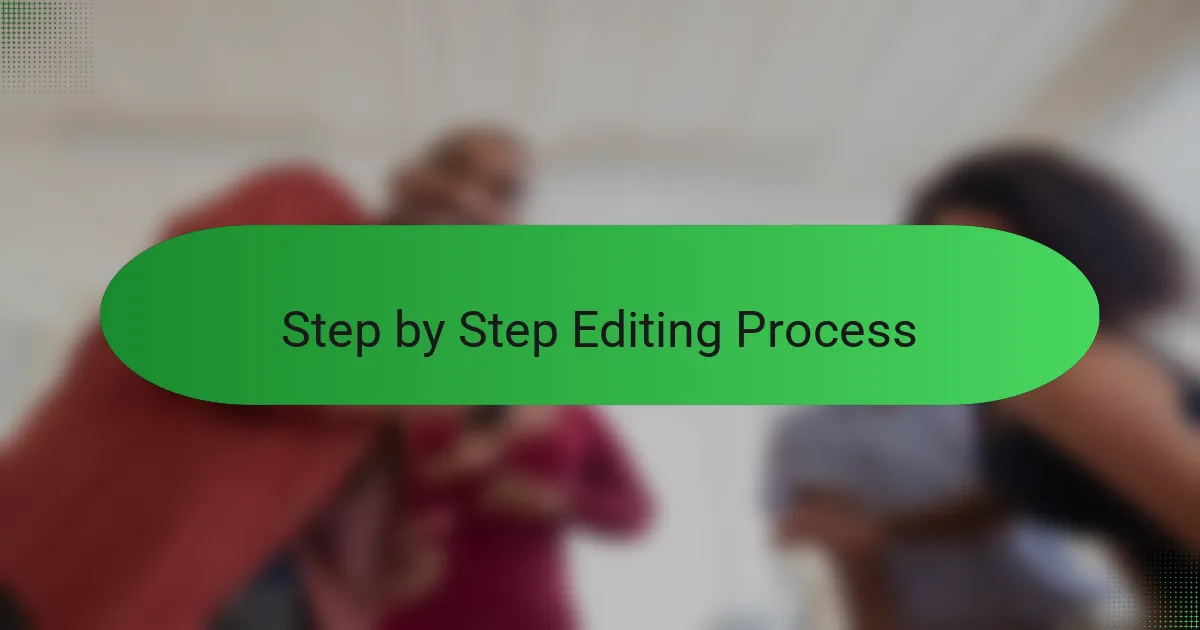
Step by Step Editing Process
Starting the editing process, I always tackle basic adjustments like exposure, contrast, and white balance first. It’s like tuning an amplifier before a show—getting those settings right sets the stage for everything else. Have you ever noticed how tweaking just a little brightness can suddenly bring out the sweat on Jon Bon Jovi’s face or the shimmer in his guitar strings? Those small fixes make the photo feel alive again.
Next comes cropping and composition refinement. I remember one particular shot where a fan’s raised hand was perfectly silhouetted against the stage lights, but the original framing felt cluttered. By zooming in and adjusting the crop, I pushed that energy front and center, almost letting you feel the crowd’s pulse. Do you see how cutting out distractions can really make the main subject pop and tell a clearer story?
Finally, I add the finishing touches—selective sharpening, noise reduction, and fine-tuning color tones. Concert images are often noisy or grainy due to low light, so this step feels like the delicate solo at the end of a song, where every note counts. Sometimes, I spend more time on one photo than I do on entire albums because nailing these details can transport you back to that wild night. Isn’t it amazing how these edits can revive memories you thought were only in your head?

Enhancing Rock Band Images
Bringing out the true spirit of a rock band in photos means enhancing more than just the obvious details. When I edit Bon Jovi’s concert shots, I focus on amplifying the intensity of stage lights and the textures of the instruments—those elements tell a story louder than words. Have you ever felt how a subtle boost in saturation can transform a photo from bland to electrifying? That’s exactly the magic I chase.
It’s tempting to over-sharpen or crank up the brightness to make images pop, but I’ve learned that restraint often delivers a more authentic vibe. Sometimes softening certain areas or letting shadows deepen creates a mood that resonates with the raw energy onstage. For me, enhancing means finding that sweet spot where the photo still breathes and lets you almost hear the roar of the crowd.
I remember working on a close-up of Jon Bon Jovi gripping his mic—you can almost feel the emotion in his stance after a few careful tweaks. Enhancing these images becomes a way to relive those moments and share that passion with fans who weren’t there. Isn’t that what makes photo editing such a thrilling art? It’s not just about correction; it’s about connection.
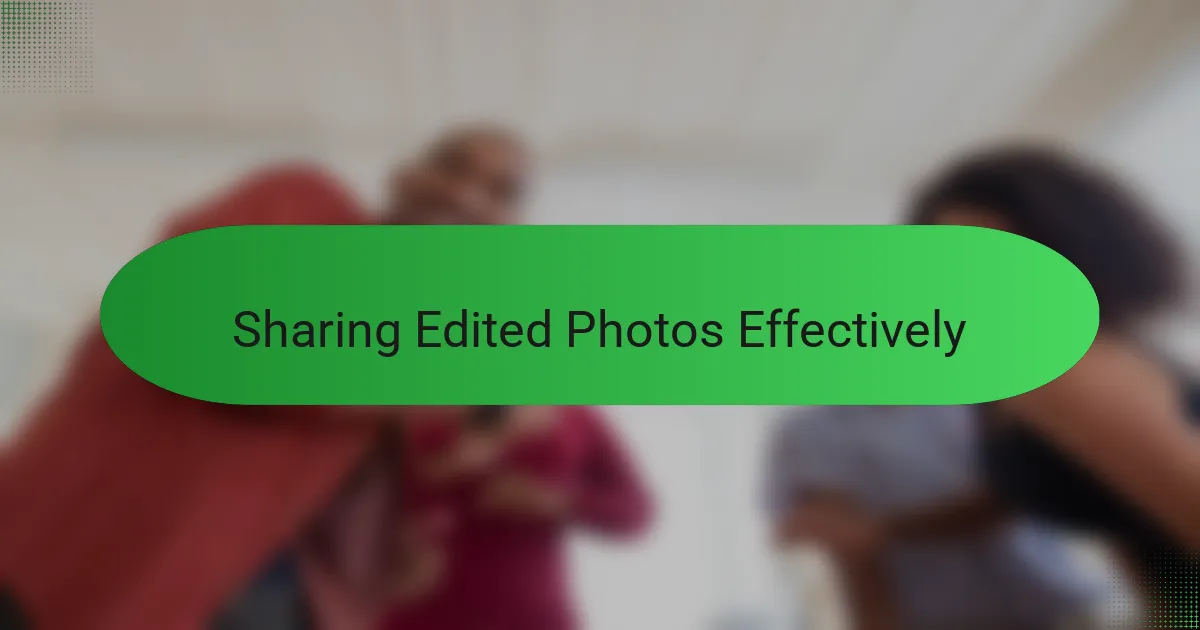
Sharing Edited Photos Effectively
Sharing edited concert photos is an art in itself. I’ve found that timing plays a huge role—posting right after the show while the excitement is still alive helps connect with fans who are buzzing about the night. Don’t you think catching that wave of energy makes the photos feel even more powerful?
When I share my Bon Jovi edits, I like to add a bit of context or a quick story about the moment captured. It turns a simple image into a shared memory—almost like we’re reliving that electric atmosphere together. Have you noticed how a caption can change the way you see a photo, making it feel more personal and vivid?
Lastly, choosing the right platform matters. Some fans prefer Instagram’s visual punch, while others dive deeper on fan forums or Facebook groups where conversations unfold. I’ve learned to tailor my posts depending on where the fans are, ensuring these snapshots reach those who will truly appreciate the energy and emotion behind each edit.
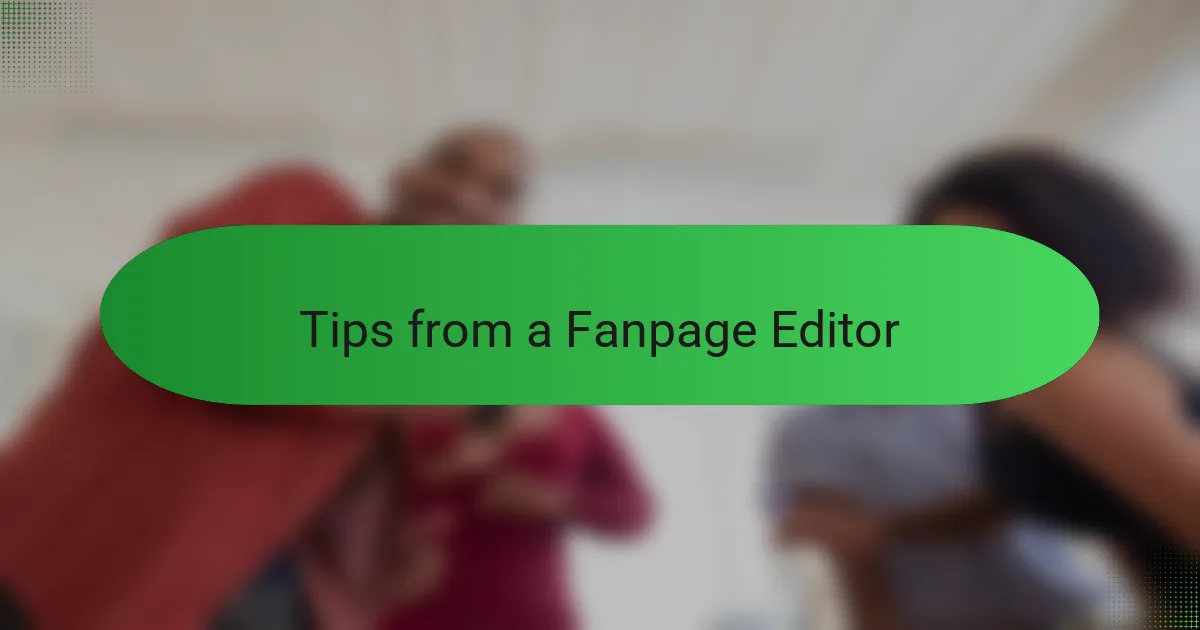
Tips from a Fanpage Editor
When I first started editing for the fanpage, I quickly realized that patience is key. Have you ever felt tempted to rush through edits just to get them online? Slowing down lets me catch those subtle moments—a fleeting smile or a wild guitar riff—that really capture the show’s soul.
One tip I always share is to trust your gut when adjusting colors and tones. Sometimes, the stage lighting throws off the camera’s settings, and relying solely on presets won’t bring out the true vibe. I remember tweaking frame after frame until the reds and blues felt as vibrant as they did live—don’t you love when a photo suddenly jumps off the screen like that?
Finally, consistency makes your fanpage stand out. I aim to maintain a signature look that fans immediately recognize while still honoring each photo’s unique energy. It’s like curating a mixtape where every track blends into the next but still shines on its own. Have you noticed how that style creates a stronger connection with fellow fans?